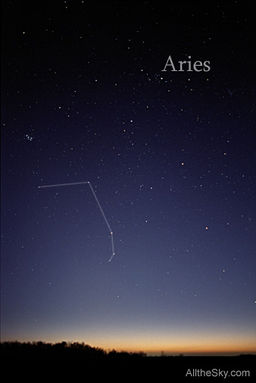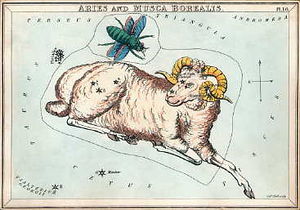Aries (constellation)
| Constellation | |
List of stars in Aries |
|
| Abbreviation | Ari |
|---|---|
| Genitive | Arietis |
| Pronunciation | pronounced /ˈɛəriːz/, or formally /ˈɛərɪ.iːz/; genitive /əˈraɪ.ɨtɨs/ |
| Symbolism | the Ram |
| Right ascension | 3 h |
| Declination | +20° |
| Quadrant | NQ1 |
| Area | 441 sq. deg. (39th) |
| Main stars | 3, 10 |
| Bayer/Flamsteed stars |
67 |
| Stars with planets | 5 |
| Stars brighter than 3.00m | 2 |
| Stars within 10.00 pc (32.62 ly) | 4 |
| Brightest star | α Ari (Hamal) (2.01m) |
| Nearest star | Teegarden's Star (12.58 ly, 3.86 pc) |
| Messier objects | 0 |
| Meteor showers |
May Arietids |
| Bordering constellations |
Perseus |
| Visible at latitudes between +90° and −60°. Best visible at 21:00 (9 p.m.) during the month of December. |
|
Aries (meaning: "ram") is one of the constellations of the zodiac, located between Pisces to the west and Taurus to the east. Its name is Latin for ram, and its symbol is ![]() (Unicode ♈), representing a ram's horns. Aries was one of the 48 constellations described by the 2nd century astronomer Ptolemy, and remains one of the 88 modern constellations today.
(Unicode ♈), representing a ram's horns. Aries was one of the 48 constellations described by the 2nd century astronomer Ptolemy, and remains one of the 88 modern constellations today.
Contents |
Notable features

Stars
Deep sky objects
The few deep sky objects in Aries are very dim. They include the galaxies NGC 697 (northwest of β Ari), NGC 772 (southeast of β Ari), NGC 972 (in the constellation's northern corner), and NGC 1156 (northwest of δ Ari).
Visualizations

Ancient Greek astronomers visualized Aries as a ram lying down with its head turned to the right. The stars α, β and γ Arietis mark the ram’s head and horns, according to Ptolemy's Almagest.
Mythology
In the ancient Babylonian calendar given in the stone tablets known as the MUL.APIN, the constellation now known as Aries was the final station along the ecliptic. It was known as MULLU.ḪUN.GA, "The Agrarian Worker". It is unclear how the "Agrarian Worker" became the "Ram" of Greek tradition, but John H. Rogers has suggested that it may have been via association with the legendary figure of Dumuzi the Shepherd. Aries only rose to its prominent position in the Neo-Babylonian revision of the Babylonian zodiac as the first point of Aries came to represent vernal equinox, replacing the Pleiades which had had this function during the Bronze Age.[1]
In Greek mythology, the constellation of Aries represents the golden ram that rescued Phrixos, taking him to the land of Colchis. Phrixos sacrificed the ram to the gods and hung its skin in a temple, where it was known as the Golden Fleece.[2]
Astrology
As of 2009[update], the Sun appears in the constellation Aries from April 19 to May 13. In tropical astrology, the Sun is considered to be in the sign Aries from March 21 to April 19, and in sidereal astrology, from April 15 to May 15.
References
- ↑ John H. Rogers, "Origins of the ancient contellations: I. The Mesopotamian traditions", Journal of the British Astronomical Association 108 (1998) 9–28
- ↑ "Astronomica", chapter 20, Hyginus, translation by Mary Grant
- H. A. Rey, The Stars—A New Way To See Them. Enlarged World-Wide Edition. Houghton Mifflin, Boston, 1997. ISBN 0-395-24830-2.
- Ian Ridpath and Wil Tirion (2007). Stars and Planets Guide, Collins, London. ISBN 978-0007251209. Princeton University Press, Princeton. ISBN 978-0691135564.
External links
- The Deep Photographic Guide to the Constellations: Aries
- NightSkyInfo.com: Constellation Aries
- Star Tales – Aries
|
|||||
|
||||||||||||||||||||||||||||||||
| Astronomy | Constellations of the Zodiac |
|---|
| Pisces ★ Aries ★ Taurus ★ Gemini ★ Cancer ★ Leo ★ Virgo ★ Libra ★ Scorpius ★ Ophiuchus ★ Sagittarius ★ Capricornus ★ Aquarius |